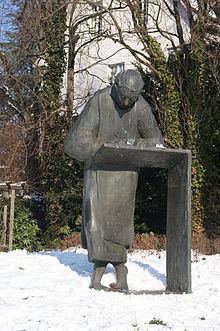Name Caesarius Heisterbach | ||
 | ||
Died 1240, Heisterbach Abbey, Konigswinter, Germany | ||
Caesarius of Heisterbach (ca. 1180 – ca. 1240) (sometimes erroneously called in English Caesar of Heisterbach) was the prior of the former Cistercian monastery Heisterbach Abbey, in the Siebengebirge near the little town of Oberdollendorf, Germany.
Contents

He is best known as the compiler of a book of hagiography, the Dialogus miraculorum, which is a collection of 746 miracle stories arranged in twelve distinctions. The tales are told in the form of dialogues between a monk and a novice. The work was often referred to by preachers seeking material for sermons in the Late Middle Ages. The work was popular and was widely distributed, showing that it catered well to the tastes of the times; it was perhaps the second largest late mediaeval best-seller, second only to the Golden Legend of Jacobus de Voragine. A vision reported in the book provided the source for the iconography of the Virgin of Mercy.
Caesarius of Heisterbach is also remembered for a maxim on the rise and fall of monasteries: he wrote that discipline causes prosperity in a monastery, and prosperity undermines discipline. He also gave the name of Titivillus as the demon who caused typographical errors in the work of scribes. He is further known as having attributed a famous statement to Arnaud Amalric, a leader in the Albigensian Crusade. Upon being asked how to distinguish Cathars from Catholics at the besieged town of Béziers, Arnaud supposedly replied "Caedite eos. Novit enim Dominus qui sunt eius", which translates as: "Slay them. God knows his own." This statement is often remembered as "Kill them all and let God sort them out."
The abbey was dissolved in 1803, when the library and archives were given to the city of Düsseldorf; the monastery and the church were sold and demolished in 1809. Though only the ruined apse with fragments of the choir remained, in 1897 a monument was erected nearby in his honour.
Preaching
The contemplative writings of Caesarius can be seen as in opposition to the mendicant orders of his lifetime.
The first writings of Caesarius were sermons, which he wrote for his own use. But it was not long before his fellow monks would approach him with requests for elaboration and explanation. His ninth book was written, because his fellow monks asked him for a simple and clearly understandable explanation of the Maria sequence "Ave preclara maris stella". The other writings were also developed on request.
Caesarius complained, in his writings, that his works were taken out of his hand, unfinished and uncorrected. Caesarius's writings were extremely well-known and popular, and there are sixty known transcriptions of the Dialogus miraculorum before the publication of the critical edition.
The work is composed of sermons and homilies. In the sermons, Caesarius treats passages from the Bible, examining psalms or parts of them. He also illuminates the relationship of the heavenly bodies to the destinies of men. The homilies, on the other hand, deal with the evangelical texts of the Sundays and festivals throughout the entire Church year. The homilies are to be regarded as theological tracts and meditations rather than sermons and speeches. They are not directed to laymen, but to members of the Cistercian Order, monks and novices. The interpretations often deal with the life of monks and monks. His writings are of great importance for medieval homiletics.
Exempla
Caesarius' activity as a novice master led him to the collection of various literature useful for preaching. He is particularly well known for his collection of exempla, the "Dialogus miraculorum" (ca. 1219-1223).
